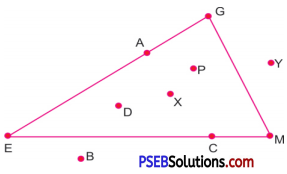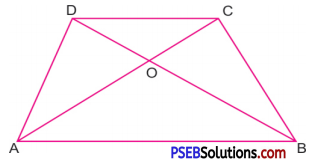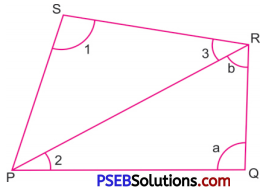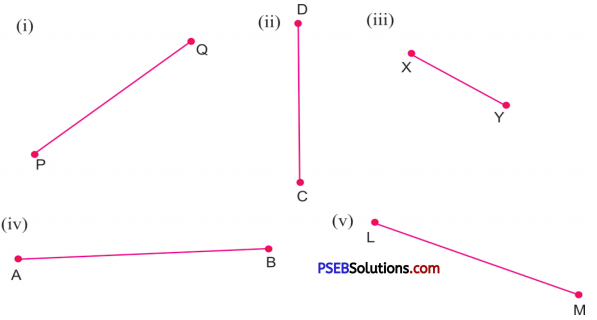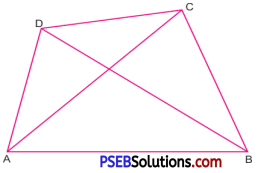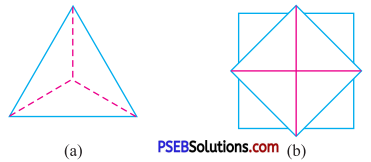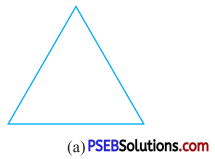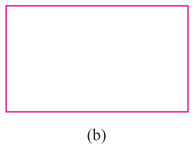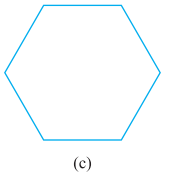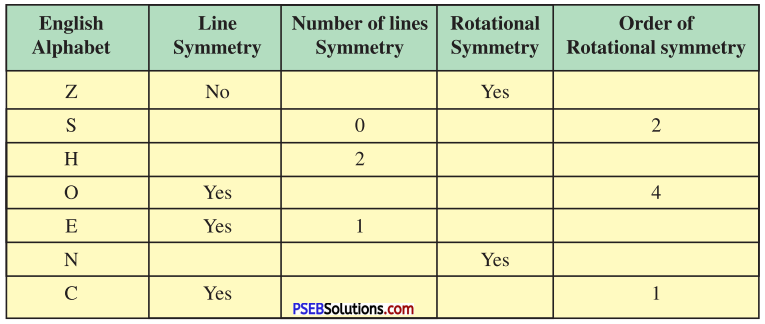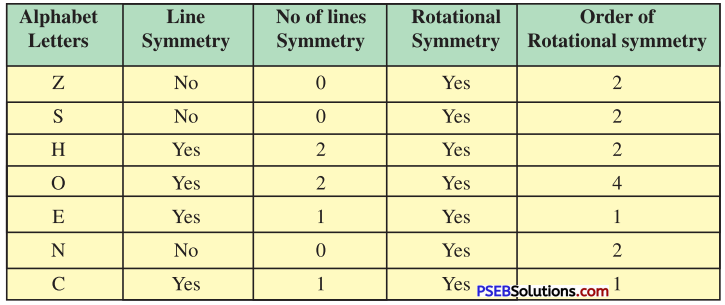Punjab State Board PSEB 10th Class Maths Book Solutions Chapter 6 Triangles Ex 6.5 Textbook Exercise Questions and Answers.
PSEB Solutions for Class 10 Maths Chapter 6 Triangles Ex 6.5
Question 1.
Sides of triangles are given below. Determine which of them are right triangles. In case of a right triangle, write the length of its hypotenuse.
(i) 7 cm, 24 cm, 25 cm
(ii) 3 cm, 8 cm, 6 cm
(iii) 50 cm, 80 cm, 100 cm
(iv) 13 cm, 12 cm, 5 cm.
Solution:
(i) Let ∆ABC, with AB = 7 cm BC = 24 cm, AC = 25 cm
AB2 + BC2 = (7)2 + (24)2
= 49 + 576 = 625
AC2 = (25)2 = 625
Now AB2 + BC2 = AC2
∴ ∆ABC is right angled triangle. Hyp. AC = 25cm.
(ii) Let ∆PQR with PQ = 3 cm, QR = 8 cm PR = 6 cm
PQ2 + PR2 = (3)2 + (6)2
= 9 + 36 = 45
QR2 = (8)2 = 64.
Here PQ2 + PR2 ≠ QR2
∴ ∆PQR is not right angled triangle.
![]()
(iii) Let ∆MNP, with MN =50 cm, NP = 80 cm, MP = 100 cm
MN 2+ NP2 = (50)2 + (80)2
= 2500 + 6400 = 8900
MP2 = (100)2 = 10000
Here MP2 ≠ MN2 + NP2.
∴ ∆MNP is not right angled triangle.
(iv) Let ∆ABC, AB = 13 cm, BC = 12 cm, AC = 5 cm
BC2 + AC2 = (12)2 + (5)2
= 144 + 25 = 169
AB2 = (13)2 = 169
∴ AB2 = BC2 + AC2
∆ABC is right angled triangle.
Hyp. AB = 13 cm.
![]()
Question 2.
PQR is a triangle right angled at P and M is a point on QR such that PM ⊥ QR. Show that PM2 = QM . MR.
Solution:
Given: ∆PQR is right angled at P and M is a point on QR such that PM ⊥ QR.
To prove : PM2 = QM × MR
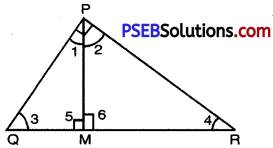
Proof: ∠P = 90° (Given)
∴ ∠1 + ∠2 = 90°
∠M = 900 (Given)
In ∆PMQ,
∠1 + ∠3 + ∠5 = 180°
=> ∠1 + ∠3 = 90° [Angle Sum Property] ………….(2) [∠5 = 90°]
From (1) and (2),
∠1 + ∠2 = ∠1 + ∠3
∠2 = ∠3
In ∆QPM and ∆RPM,
∠3 = ∠2 (Proved)
∠5 = ∠6 (Each 90°)
∴ ∆QMP ~ ∆PMR [AA similarity]
\(\frac{{ar} .(\Delta \mathrm{QMP})}{{ar} .(\Delta \mathrm{PMR})}=\frac{\mathrm{PM}^{2}}{\mathrm{MR}^{2}}\)
[If two triangles are similar, ratio o their areas is equal to square of corresponding sides]
\(\frac{\frac{1}{2} \mathrm{QM} \times \mathrm{PM}}{\frac{1}{2} \mathrm{RM} \times \mathrm{PM}}=\frac{\mathrm{PM}^{2}}{\mathrm{MR}^{2}}\)
[area of ∆ = \(\frac{1}{2}\) Base × Altitude]
\(\frac{\mathrm{QM}}{\mathrm{RM}}=\frac{\mathrm{PM}^{2}}{\mathrm{RM}^{2}}\)PM2 = QM × RM Hence proved.
![]()
Question 3.
In fig., ABD is a triangle right angled at A and AC ⊥ BD. Show that
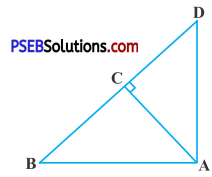
(i) AB2 = BC.BD
(ii) AC2 = BC.DC
(üi) AD2 = BD.CD.
Solution:
Given. A right angled ∆ABD in which right angled at A and AC ⊥ BD.
To Prove:
(i) AB2 = BC.BD
(ii) AC2 = BC.DC .
(iii) AD2 = BD.ÇD .
Proof. In ∆DAB and ∆DCA,
∠D = ∠D (common)
∠A = ∠C (each 90°)
∴ ∆DAB ~ ∆DCA [AA similarity]
In ∆DAB and ∆ACB,
∠B = ∠B (common)
∠A = ∠C . (each 90°)
∴ ∆DAB ~ ∆ACB, .
From (1) and (2),
∆DAB ~ ∆ACB ~ ∆DCA.
(i) ∆ACB ~ ∆DAB (proved)
∴ \(\frac{{ar} .(\Delta \mathrm{ACB})}{{ar} .(\Delta \mathrm{DAB})}=\frac{\mathrm{AB}^{2}}{\mathrm{DB}^{2}}\)
[If two triangles are similar corresponding sides are proportional]
\(\frac{\frac{1}{2} \mathrm{BC} \times \mathrm{AC}}{\frac{1}{2} \mathrm{DB} \times \mathrm{AC}}=\frac{\mathrm{AB}^{2}}{\mathrm{DB}^{2}}\)
[Area of triangle = \(\frac{1}{2}\) Base × Altitude]
BC = \(\frac{\mathrm{AB}^{2}}{\mathrm{BD}}\)
AB2 = BC × BD.
(iii) ∆ACB ~ ∆DCA (proved)
\(\frac{{ar} .(\Delta \mathrm{DAB})}{{ar} .(\Delta \mathrm{DCA})}=\frac{\mathrm{DA}^{2}}{\mathrm{DB}^{2}}\)
[If two triangles are similar corresponding sidec are proportional]
CD = \(\frac{\mathrm{AD}^{2}}{\mathrm{BD}}\)
⇒ AD2 = BD × CD.
![]()
Question 4.
ABC is an isosceles triangle right angled at C. Prove that AB2 = 2AC2.
Solution:
Given: ABC is an isosceles triangle right angled at C.
To prove : AB2 = 2AC2.
Proof: In ∆ACB, ∠C = 90° & AC = BC (given)
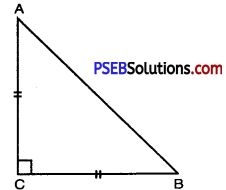
AB2 = AC2 + BC2
[By using Pythagoras Theorem]
=AC2 + AC2 [BC = AC]
AB2 = 2AC2
Hence proved.
Question 5.
ABC is an isosceles triangle with AC = BC. If AB2 = 2AC2, prove that ABC is right triangle.
Solution:
Given: ∆ABC is an isosceles triangle AC = BC
To prove: ∆ABC is a right triangle.
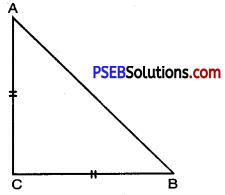
Proof: AB2 = 2AC2 (given)
AB2 = AC2 + AC2
AB2 = AC2 + BC2 [AC = BC]
∴ By Converse of Pythagoras Theorem,
∆ABC is right angled triangle.
![]()
Question 6.
ABC is an equilateral triangle of side 2a. Find each of its altitudes.
Solution:
∆ABC is equilateral triangle with each side 2a
AD ⊥ BC
AB = AC = BC = 2a
∆ADB ≅ ∆ADC [By RHS Cong.]
∴ BD = DC = a [c.p.c.t]
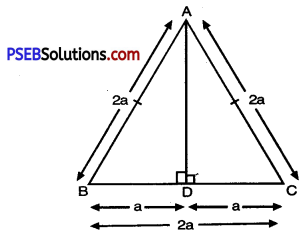
In right angled ∆ADB
AB2 = AD2 + BD2
(2a)2 = AD2 + (a)2
4a2 – a2 = AD2.
AD2 = 3a2
AD = √3a.
Question 7.
Prove that the sum of the squares of the sides of a rhombus is equal to the sum of the squares of its diagonals. [Pb. 2019]
Solution:
Given: Rhombus, ABCD diagonal AC and BD intersect each other at O.
To prove:
AB2 + BC2 + CD2 + AD2 = AC2 + BD2
Proof:The diagonals of a rhombus bisect each other at right angles.
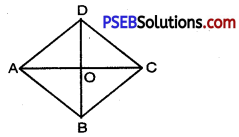
∴ AO = CO, BO = DO
∴ ∠s at O are rt. ∠s
In ∆AOB, ∠AOB = 90°
∴ AB2 = AO2 + BO2 [By Pythagoras Theorem] …………..(1)
Similarly, BC2 = CO2 + BO2 ……………..(2)
CD2 = CO2 + DO2 ……………(3)
and DA2 = DO2 + AO2 ……………….(4)
Adding. (1), (2), (3) and (4), we get
AB2 + BC2 + CD2 + DA2 = 2AO2 + 2CO2 + 2BO2 + 2DO2
= 4AO2 + 4BO2
[∵ AO = CO and BO = DO]
= (2AO)2 + (2BO)2 = AC2 + BD2.
![]()
Question 8.
In fig., O is a point In the interior of a triangle ABC, OD ⊥ BC, OE ⊥ AC and OF ⊥ AB. Show that
(i) OA2 + OB2 + OC2 – OD2 – OE2 – OF2 = AF2 + BD2 + CE2
(ii)AF2 + BD2 + CE2 = AE2 + CD2 + BF2.
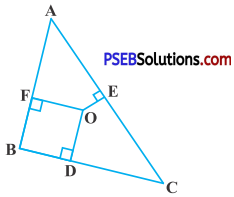
Solution:
Given: A ∆ABC in which OD ⊥ BC, 0E ⊥ AC and OF ⊥ AB.
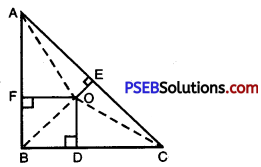
To prove:
(i) AF2 + BD2 + CE2 = OA2 + OB2 + OC2 – OD2 – OE2 – OF2
(ii) AF2 + BD2 + CE2 = AE2 + CD2 + BF2.
Construction: Join OB, OC and OA.
Proof: (i) In rt. ∠d ∆AFO, we have
OA2 = OF2 + AF2 [By Pythagoras Theorem]
or AF2 = OA2 – OF2 …………..(1)
In rt. ∠d ∆BDO, we have:
OB2 = BD2+ OD2 [By Pythagoras Theorem]
⇒ BD2 = OB2 – OD2 …………..(2)
In rt. ∠d ∆CEO, we have:
OC2 = CE2 + OE2 [By Pythagoras Theorem]
⇒ CE2 = OC2 – OE2 ……………(3)
∴ AF2 + BD2 + CE2 = OA2 – OF2 + OB2 – OD2 + OC2 – 0E2
[On adding (1), (2) and (3)]
= OA2 + OB2 + OC2 – OD2 – OE2 – OF2
which proves part (1).
Again, AF2 + BD2 + CE2 = (OA2 – OE2) + (OC2 – OD2) + (OB2 – OF2)
= AE2 + CD2 + BF2
[∵AE2 = AO2 – OE2
CD2 = OC2 – OD2
BF2 = OB2 – OF2].
![]()
Question 9.
A ladder 10 m long reaches a window 8 m above the ground. Find the distance of the foot of the ladder from base of the wall.
Solution:
Height of window from ground (AB) = 8m.
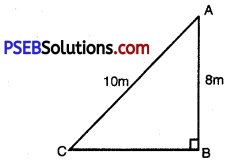
Length of ladder (AC) = 10 m
Distance between foot of ladder and foot of wall (BC) = ?
In ∆ABC,
AB2 + BC2 = AC2 [By Pythagoras Theorem]
(8)2 + (BC)2 = (10)2
64 + BC2 = 100
BC2 = 100 – 64
BC = √36
BC = 6 cm.
∴ Distance between fóot of ladder and foot of wall = 6 cm.
Question 10.
A guy wire attached to a vertical pole of height 18 m Is 24 m long and has a stake attached to the other end. How far from the base of the pole should the stake be driven so that the wire will be taut?
Solution:
Let AB is height of pole (AB) = 18 m
AC is length of wire = 24 m
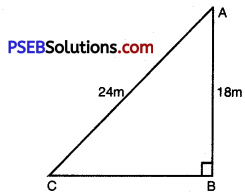
C is position of stake AB at ground level.
In right angle triangle ABC,
AB2 + BC2 = AC2 [By Pythagoras Theorem]
(18)2 + (BC)2 = (24)2
324 + (BC)2 = 576
BC2 = 576 – 324
BC = \(\sqrt{252}=\sqrt{36 \times 7}\)
BC = 6√7 m.
![]()
Question 11.
An aeroplane leaves an airport and flies due north at a speed of 1000 km per hour. At the same time, another aeroplane leaves the same airport and flies due west at a speed of 1200 km per hour. How far apart will be the two pLanes after 1\(\frac{1}{2}\) hours?
Solution:
Speed of first aeroplane = 1000km/hr.
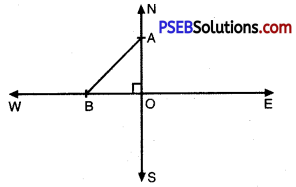
Distance covered by first aeroplane due north in 1\(\frac{1}{2}\) hours =1000 × \(\frac{3}{2}\)
OA = 1500 km
Speed of second aeroplane = 1200 km/hr.
Distance covered by second aeroplane in 1\(\frac{1}{2}\) hours = 1200 × \(\frac{3}{2}\)
OB = 1800 km.
In right angle ∆AOB
AB2 = AO2 + OB2 [By Phyrhagoras Theorem]
AB2 = (1500)2 + (1800)2
AB = \(\sqrt{2250000+3240000}\)
= \(\sqrt{5490000}\)
= \(\sqrt{61 \times 90000}\)
AB = 300√61 km.
Hence, Distance between two aeroplanes = 300√61 km.
Question 12.
Two poles of heights 6 m and 11 m stand on a plane ground. If the distance between the feet of the poles is 12 m, find the
distance between their tops.
Solution:
Height of pole AB = 11 m
Height of pole (CD) = 6 m
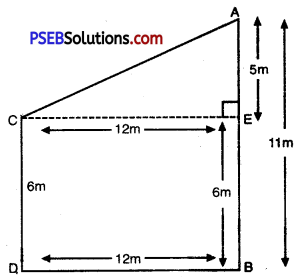
Distance between foot of pole = 12 m
from C draw CE ⊥ AB. such that
BE = DC = 6 m
AE = AB – BE = (11 – 6) m = 5 m.
and CE = DB = 12 m.
In rt. ∠d ∆AEC,
AC2 = AE2 + FC2
[By Phythagoras Theorem)
AC = \(\sqrt{(5)^{2}+(12)^{2}}\)
= \(\sqrt{25+144}\)
= \(\sqrt{169}\) = 13.
Hence, Distance between their top = 13m.
![]()
Question 13.
D and E are points on the sides CA and CB respectively of a triangle ABC right angled at C.
Prove that AE2 + BD2 = AB2 + DE2.
Solution:
Given: In right angled ∆ABC, ∠C = 90° ;
D and E are points on sides CA & CB respectively.
To prove: AE2 + BD2 = AB2 + DE2
Proof: In rt. ∠d ∆BCA,
AB2 = BC2 + CA2 …………..(1) [By Pythagoras Theorem]
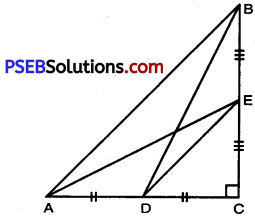
In rt. ∠d ∆ECD,
DE2 = EC2 + DC2 ……………….(2) [By Pythagoras Theorem]
In right angled triangle ∆ACE,
AE2 = AC2 + CE2 ……………….(3)
In right angled triangle ∆BCD
BD2 = BC2 + CD2 ……………….(4)
Adding (3) and (4),
AE2 + BD2 = AC2 + CE2 + BC2 + CD2
= [AC2 + CB2] + [CE2 + DC2]
= AB2 + DE2
[From (1) and (2)]
Hence 2 + BD2 = AB2 + DE2.
Which is the required result.
Question 14.
The perpendicular from A on side BC of a ∆ABC intersects BC at D such that DB = 3 CD. Prove that 2AB2 = 2AC2 + BC2.
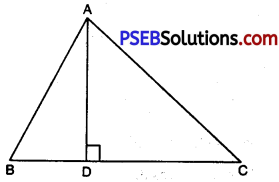
Solution:
Given: ∆ABC, AD ⊥ BC
BD = 3CD.
To prove: 2AB2 = 2AC2 + BC2.
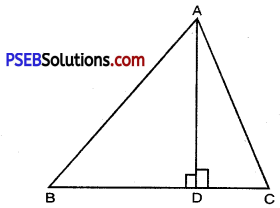
Proof: In rt. ∠d triangles ADB and ADC, we have
AB2 = AD2 + BD2;
AC2 = AD2 + DC2 [By Pythagoras Theorem]
∴ AB2 – AC2 = BD2 – DC2
= 9 CD2 – CD2; [∵ BD = 3CD]
= 8CD2 = 8 (\(\frac{\mathrm{BC}}{4}\))2
[∵ BC = DB + CD = 3 CD + CD = 4 CD]
∴ CD = \(\frac{1}{4}\) BC
∴ AB2 – AC2 = \(\frac{\mathrm{BC}^{2}}{2}\)
⇒ 2(AB2 – AC2) = BC2
⇒ 2AB2 – 2AC2 = BC2
∴ 2AB2 = 2AC2 + BC2.
Which is the required result.
![]()
Question 15.
In an equilateral triangle ABC, D is a point on side BC such that BD = \(\frac{1}{3}\) BC. Prove that 9 AD2 = 7 AB2.
Solution:
Given: Equilateral triangle ABC, D is a point on side BC such that BD = \(\frac{1}{3}\) BC.
To prove: 9AD2 = 7 AB2.
Construction: AB ⊥ BC.
Proof: ∆AMB ≅ ∆AMC [By R.HS. Rule since AM = AM and AB = AC]
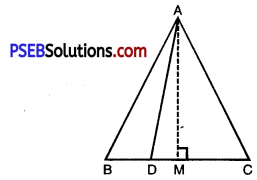
∴ BM = MC = \(\frac{1}{2}\) BC [c.p.c.t.]
Again BD = \(\frac{1}{3}\) BC and DC = \(\frac{1}{3}\) BC (∵ BC is trisected at D)
Now in ∆ADC, ∠C is acute
∴ AD2 = 2AC2 + DC2 – 2 DC × MC
= AC2 + \(\left[\frac{2}{3} \mathrm{BC}\right]^{2}\) – 2 \(\left[\frac{2}{3} \mathrm{BC}\right] \frac{1}{2} \mathrm{BC}\)
[∵ DC = \(\frac{2}{3}\) BC and MC = \(\frac{1}{2}\) BC]
= AB2 + \(\frac{4}{9}\) AB2 – \(\frac{2}{3}\) AB2
[∵ AC = BC = AB]
= (1 + \(\frac{4}{9}\) – \(\frac{2}{3}\)) AB2
= \(\left(\frac{9+4-6}{9}\right) \mathrm{AB}^{2}=\frac{7}{9} \mathrm{AB}^{2}\)
∴ AD2 = \(\frac{7}{9}\) AB2
⇒ 9 AD2 = 7 AB2.
Question 16.
In an equilateral triangle, prove that three times the square of one side Ls equal to four times the square of one of its
altitudes.
Solution:
Given:
ABC is equilateral ∆ in which AB = BC = AC
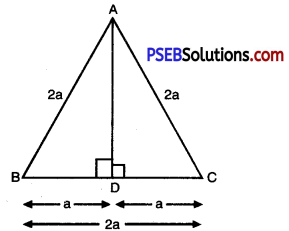
To prove: 3 AB2 = 4 AD2
Proof: In right angled ∆ABD,
AB2 = AD2 + BD2 (Py. theorem)
AB2 = A BD2 (Py. theorem)
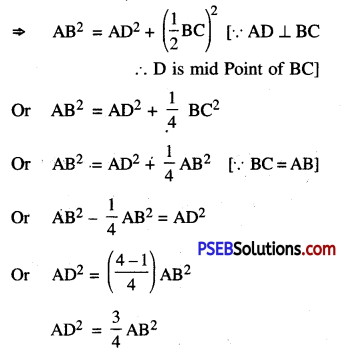
AD2 = \(\frac{3}{4}\) AB2
⇒ 4 AD2 = 3 AB2
Hence, the result.
![]()
Question 17.
Tick the correct answer and justify: In ∆ABC, AB = 6 cm, AC = 12 cm and BC = 6√3 cm. [The angles of B are respectively
(A) 120°
(B) 64°
(C) 90°
(D) 45°
Solution.
AC = 12 cm
AB = 6√3 cm
BC = 6 cm
AC2 = (12)2 = 144 cm
AB2 + BC2 = (6√3)2 + (6)2
= 108 + 36
AB√3 + BC√3 = 144
∴ AB√3 + BC√3 = AC√3
Hence by converse of pythagoras theorem ∆ABC is right angred triangle right angle at B
∴ ∠B = 90°
∴ correct option is (C).


